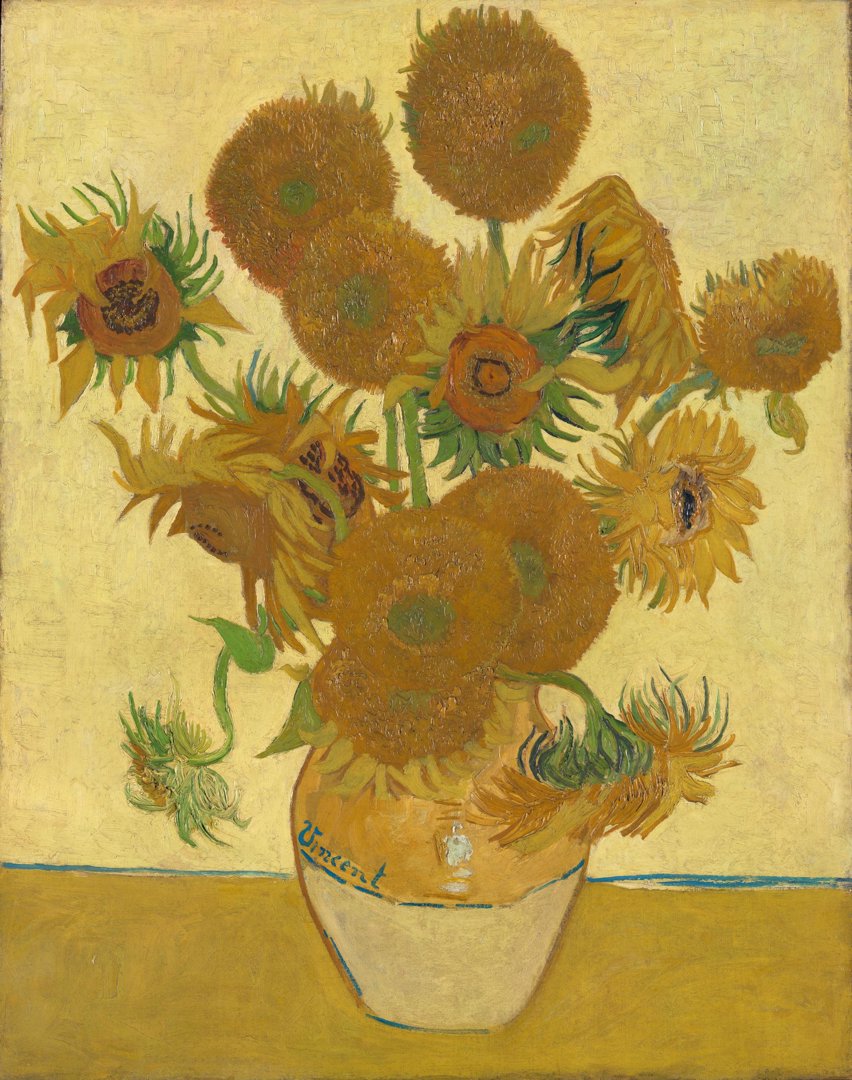Vincent van Gogh's 'Sunflowers'
Audio description
This is a description of 'The Sunflowers', by the Dutch artist Vincent Van Gogh, painted in 1888. Oil on canvas, the picture is 92cm high by 73cm wide, in a plain wooden frame.
One of the most recognisable paintings in the history of art, it depicts a slightly larger than life vase of 15 sunflowers, in front of a pale-yellow background. The flowers are carefully observed - each at a different stage in their life-cycle. But this is not a photographic-like depiction. Van Gogh presents us with a unique, powerfully expressive approach to this timeless theme.
A vibrant energy radiates from the jagged spiky flowerheads, in a bold ‘yellow on yellow’ colour combination. The paint is thickly applied in most places - a style of painting termed ‘impasto’ (from the Italian word for dough). We can imagine Van Gogh in the act of painting, the traces of his brush visible in the textured surfaces.
Most of the background is painted in a luminous pale wheat-yellow, applied with criss-crossed hatched brushstrokes. The mustard-coloured surface the vase stands on is painted as a horizontal strip across the bottom 5th of the painting. Applied with smoother brushstrokes, it has a flatter appearance. Where these two yellows meet, Van Gogh has used a thin contrasting line of bright blue to separate them.
The vase is a bulbous oval shape with the appearance of simple country-cottage stoneware. It is painted in two bands of yellow, darker at the top, to stand out against the background colours. The two yellows are separated by a thin blue line, above which he has signed his name ‘Vincent’ in the same blue, on the left of the vase. A few thick daubs of white paint in the centre suggest light reflecting off its surface.
The arrangement of flowers at first appears haphazard, but the flowerheads fall into rough groupings. On either side of the vase, newly developing sunflowers, with curved stems, droop over. The yellow petals of the smaller bud on the left are curled up, having just emerged from their encasement of thin green leaf-like structures, known as ‘bracts’, which frill out around them.
Above these new buds on each side, is a cluster of 3 flowers, the lowest proudly in full bloom while those above are starting to shed their petals. One, furthest to the
right, clings on to a solitary tear-shaped petal. The centre of these flowers are dotted with dark brown to indicate developing sunflower seeds.
A central flower is at the halfway stage, its top half crowned with an arch of spiky petals, while underneath is bare save for some green bracts. Its orange centre is beginning to develop a brown ring of seeds.
The display is finished by two clusters of 3 larger, heavier seed heads, one at the pinnacle of the arrangement, another at its lowest point, overlapping the front of the vase. Here the paint is thickest, applied in ochre-coloured, lively repetitive dabs, with short olive-green flicks at their centres.
While some painters thought sunflowers too coarse a subject to spend their time on, Van Gogh enthusiastically painted them many times. His first four versions were done in just one week of August 1888, while at the ‘yellow house’, his rented home in Arles. They were painted in optimistic anticipation of a visit from fellow artist Paul Gauguin. But Van Gogh and Gauguin’s time together in Arles ended in a disastrous and violent falling out.
In painting his sunflowers Van Gogh achieved a kind of immortality and the magnetic energy of this painting continues to inspire all who encounter 'The Sunflowers' to this day.


